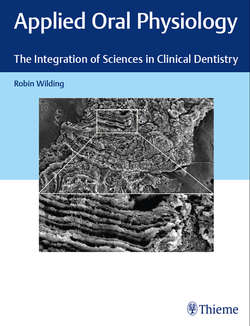Читать книгу Applied Oral Physiology - Robin Wilding - Страница 22
На сайте Литреса книга снята с продажи.
2.2.6 Dental Pulp Hyperemia
ОглавлениеIf the progress of an advancing carious lesion is rapid, there is insufficient time for secondary dentin to form, and odontoblasts are damaged by bacterial products. Their damage invokes an inflammatory response, with hyperemia, the arrival of inflammatory cells, and the potential for a localized abscess in that part of the pulp closest to the caries lesion. This is a critical point in the progress of pulp damage. If the irritation can be removed by removing the carious dentin and sealing the cavity, pulpal hyperemia may subside. If, however, the hyperemia is extensive and severe, the damage is irreversible and the pulp tissue must be removed by endodontic treatment.
From a clinical point of view, it is difficult to determine whether pulp hyperemia is reversible or irreversible, but there are some guidelines. Firstly, it is suggested that if the sensitivity to stimulation with hot or cold is short-lived, and the pain disappears soon after the stimulus is removed, the situation is hopeful for retaining the pulp tissue. Continual pain after stimulation suggests that the outlook for the pulp tissue is poor and that the pulp damage is widespread. Recall that the pulp is encased in a rigid shell and has a small opening for blood vessels. It is therefore highly vulnerable to vascular congestion and increased tissue pressure. The age of the tooth has a bearing on the outlook for a hyperemic tooth. Younger teeth with open apical foramina allow optimum vascular flow through the pulp, less venous congestion, and therefore greater healing potential than older teeth with narrow apical foramina.
Fig. 2.12 A histological section through the pulp–dentin of a tooth affected by dental caries. (a) Normal odontoblast cells in an area of the tooth crown unaffected by caries (magnification × 200). (b) In another part of the same tooth, bacteria (B) in the dentinal tubules seen as fine black stains are advancing toward the pulp. In response to the irritation caused by bacteria, the odontoblasts (OB) and other pulp cells have increased in size and number and there is a greater vascular supply to the tissue (BV). A layer of predentin which will become reparative dentin (RD) has been formed to protect the pulp.
If infected pulp tissue is not removed, further spread may occur into the periodontal ligament through the apex of the tooth and may also communicate with the periodontium via accessory root canals (▶ Fig. 2.9). These routes of communication with the periodontium are responsible for periapical abscess formation and further spread of infection into the alveolar bone. Infected pulp tissue must be removed and the empty spaces of the pulp chamber and root canal sealed up. This process, known as endodontic therapy, requires an intimate knowledge of the anatomy of pulp chambers and root canals. A brief and simplified version is presented below.
